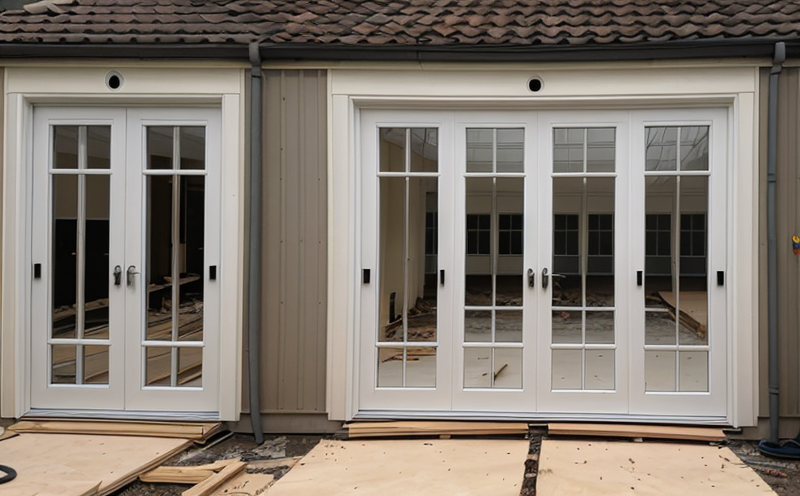Fire Resistance Testing of Hollow Core Doors
The fire resistance testing of hollow core doors is a critical aspect of ensuring compliance with local and international standards. Hollow core doors are widely used in residential, commercial, and institutional buildings due to their cost-effectiveness and ease of installation. However, the fire safety performance of these doors must be rigorously assessed to meet regulatory requirements and ensure occupant safety during emergencies.
Fire resistance testing evaluates a door's ability to withstand exposure to intense heat for a specified duration without compromising its integrity or function. This includes preventing flames from spreading through gaps or openings in the door, maintaining structural stability, and providing adequate smoke control. The test is conducted under controlled laboratory conditions that simulate real-world fire scenarios.
During testing, hollow core doors are subjected to increasing temperatures, typically up to 1000°C (1832°F), while exposed to flames for a defined period. The door's performance is monitored using various parameters such as heat flow, smoke generation, and structural integrity. Compliance with standards like ASTM E1414-19 or EN 1634-1 ensures that the tested doors meet specific criteria regarding fire resistance.
The testing process involves meticulous preparation of the specimen to ensure accurate results. This includes cleaning the door surface, ensuring it is free from contaminants and debris, and checking for any defects that could affect the test outcome. The specimen is then placed in a specially designed furnace equipped with a controlled atmosphere and temperature profile.
Throughout the testing process, critical parameters are continuously monitored to assess the door's performance. These include:
- Temperature at various points on the door
- Flame propagation through gaps or openings
- Structural stability of the door frame and panels
- Smoke generation and release rates
- Door closure integrity under fire conditions
The test concludes when the specified duration has elapsed, at which point the performance data is analyzed to determine compliance with the relevant standards. Non-compliant doors may need modifications or further testing until they meet all required specifications.
In addition to meeting regulatory requirements, fire resistance testing of hollow core doors offers several benefits that are crucial for building safety and occupant protection:
- Enhanced Safety: Ensures that doors can effectively contain fires and prevent smoke from spreading, thereby protecting occupants and firefighters.
- Compliance with Regulations: Helps buildings comply with local, national, and international fire codes, avoiding potential legal issues and fines.
- Increased Property Value: Buildings certified for fire safety are often more attractive to buyers or tenants due to improved safety features.
- Reduced Insurance Costs: Fire-resistant doors can lead to lower insurance premiums by reducing the risk of property damage and injuries.
- Improved Reputation: Demonstrating a commitment to safety through rigorous testing enhances the reputation of both the building owner and the construction company involved.
- Long-Term Durability: The testing process helps identify potential weaknesses in door design, leading to more durable products that can withstand harsh environmental conditions over time.
- Innovation and Improvement: Testing provides valuable insights for R&D engineers and designers to innovate and improve fire safety features.
By investing in comprehensive fire resistance testing of hollow core doors, organizations can ensure they are adhering to the highest standards of quality and reliability. This not only protects lives but also contributes to a safer built environment.
Applied Standards
The fire resistance testing of hollow core doors is governed by several international standards that provide clear guidelines for conducting these tests. The most commonly referenced standards include:
- American Society for Testing and Materials (ASTM) E1414-19: This standard specifies the procedure for measuring the fire resistance of doors, including hollow core doors.
- European Norms (EN 1634-1): Provides specifications for doors used in buildings, detailing their performance under fire conditions.
- British Standards Institution (BS) 8414:2009: Offers guidance on the testing of fire doors, including hollow core types.
These standards are widely recognized and accepted globally, ensuring consistency in test procedures and results. Compliance with these standards is essential for obtaining certification and ensuring that products meet regulatory requirements.
Quality and Reliability Assurance
The quality and reliability of fire resistance testing are paramount in maintaining public safety and ensuring compliance with regulations. Our laboratory adheres to strict protocols and uses state-of-the-art equipment to conduct these tests accurately and consistently. We employ skilled technicians who are trained in the latest testing methodologies, ensuring that each test is conducted rigorously.
Our commitment to quality extends beyond just meeting standards; we strive for excellence by providing detailed reports that offer comprehensive insights into the performance of tested hollow core doors. These reports help stakeholders make informed decisions and implement necessary improvements if required.
We also offer training sessions to educate clients on best practices in fire resistance testing, helping them understand the importance of this process and how it contributes to overall building safety. By fostering a culture of continuous improvement, we aim to contribute to safer communities worldwide.





